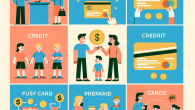
Direct Debit vs Standing Order vs Faster Payment (Yeah, I Was Confused Too)
How to Create Your First Budget (Without Losing Your Mind)
Hey there, friend. I see you’re just starting your journey into the world of personal finance—welcome! I’m Thomas “Tom” Bradley, your resident finance nerd, plain-English translator of big scary money words, and the guy who believes budgeting isn’t a prison—it’s a ticket to freedom (with maybe a dash of boring spreadsheets).
If the word “budget” makes you want to run for the hills faster than a squirrel with a caffeine drip, take a breath. This article is your no-guilt, no-jargon, no-snooze walkthrough of how to create your first budget. It won’t be painful—I promise. In fact, you might even have fun. (Yes, I said fun. Let’s go!)
Why You Need a Budget (Even If You Think You Don’t)
Look, I get it. Budgeting sounds like something your boring uncle talks about at family dinners while slowly chewing steak. But here’s the truth:
- Budgets help you take control of your money, instead of your money controlling you.
- They show you where your money goes, so you can plug the leaks.
- You don’t have to be broke or drowning in debt to need a budget. Even millionaires use them. (Actually, especially millionaires use them.)
A good budget is like Google Maps for your wallet—it guides you, reroutes you when you mess up, and helps you reach your destination without panic attacks.
Step 1: Know Your Net Income (The Starting Line)
Before we start slicing and dicing your money like a cooking show, you need to know how much money you’re really working with. That means figuring out your net income—the amount that hits your bank account after taxes, insurance, retirement, and your company’s semi-annual pizza party fund.
If you’re salaried, this is easy. Look at your paycheck. If you freelance or have variable income, take your monthly average from the last three to six months. Always go with the lower average during uncertain times. Budgeting with dream-level income is like trying to fly a paper airplane to Mars. Nope.
Step 2: Track Your Expenses (Yes, Even the Coffee)
This step feels annoying at first, but stick with it—it’s an eye-opener. For one month, write down every single thing you spend money on. Yes, including:
- Your rent or mortgage
- Groceries (and those “I just went in for milk and came out $60 lighter” moments)
- Transportation (gas, bus fare, Uber rides that you said you’d stop taking)
- Subscriptions (Netflix, Spotify, that meditation app you forgot about)
- Fun stuff (coffee, Friday night pizza, impulse Amazon purchases at 1am)
You can use an app like Mint, YNAB, or even a good old-fashioned spreadsheet. I once had a student track their expenses on sticky notes. Not recommended, but it worked… until their cat ate three of them.
Step 3: Categorize and Create Your Budget
Now that you’ve got the raw numbers, it’s time to give every dollar a job. Sort your expenses into categories. Here’s a simple way to break it down using the 50/30/20 rule—it’s great for beginners:
- 50% Needs: Housing, groceries, transportation, insurance, basic utility bills. Basically, anything without which you’d be in trouble.
- 30% Wants: Eating out, entertainment, hobbies, date nights, online shopping binges (within reason).
- 20% Savings & Debt Repayment: Emergency fund, debt payments above minimum, retirement savings.
Let’s say your net income is $3,000/month. Here’s how that breaks down:
- Needs = $1,500
- Wants = $900
- Savings/Debt Repayment = $600
If your needs are eating more than 50%, don’t panic. Adjust. Trim where you can. Maybe move that “Wants” money down a bit and boost up savings over time. A budget isn’t written in stone—it’s more like Play-Doh. Squishy, flexible, and designed to be played with.
Step 4: Choose a Budgeting Method That Matches Your Style
One size does not fit all—especially not in budgeting. Try a few and see what sticks:
1. Zero-Based Budget
Every dollar you earn is assigned to something: bills, savings, pizza, whatever—until you literally have $0 “left over.” It’s great for control freaks, and I mean that lovingly.
2. Envelope System (Digital or Physical)
Popularized by a certain well-known finance guy with a radio show, this method involves setting aside cash in envelopes for each category. There are digital versions now, too. When the envelope for “eating out” is empty, you’re done eating out. No fries for you.
3. Pay Yourself First
You put money into savings and investments first, and what’s left is for expenses. Excellent for future-focused folks who tend to “accidentally” spend money meant for goals. (We’ve all been there.)
Step 5: Review, Tweak, and Don’t Be a Perfectionist
Let me be real: The first month of budgeting is basically an experiment. You may forget to write things down, underestimate your food budget, or realize you spend $120 a month on tacos (been there). It’s okay.
Adjust. Learn. Laugh at yourself. Budgeting isn’t about being perfect. It’s about being aware and intentional. That’s where the real magic happens.
But Tom, What If I Mess Up?
My friend, let me share the ancient wisdom of every budget master who has ever eaten a $5 impulse donut: You will mess up. And that’s fine.
The key is to get back on track without shame. Shame is not a budgeting tool—it just makes you give up and order more donuts. Learn from it. Tweak the numbers. Move on.
Take the First Step Today
Don’t wait until next month. Or next Monday. Or after Mercury exits retrograde. Today is the perfect day to start.
Crack open that bank app. Jot down what you spent this week. Pick a budgeting method that feels least terrifying. Budgeting is a skill, not a talent—and like any skill, the more you practice, the better you’ll get.
And remember, if today wasn’t picture-perfect, tomorrow’s another shot. You’ve got this.
Want to learn more about building a strong financial foundation? Check out our About Us page to understand our mission, or contact us any time. We’re here for you, one responsible dollar at a time.









Leave a Reply